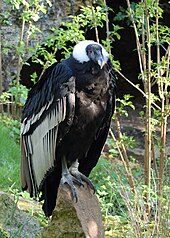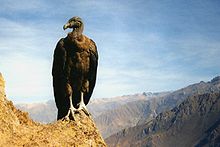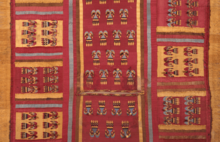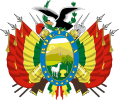Andean condor
| Andean condor | |
|---|---|

| |
| Male Andean condor at the Cincinnati Zoo .
| |
| Scientific classification | |
| Domain: | Eukaryota |
| Kingdom: | Animalia |
| Phylum: | Chordata |
| Class: | Aves |
| Order: | Cathartiformes |
| Family: | Cathartidae |
| Genus: | Vultur Linnaeus, 1758 |
| Species: | V. gryphus
|
| Binomial name | |
| Vultur gryphus | |

| |
| Yellow – approximate range/distribution | |
| Synonyms | |
The Andean condor (Vultur gryphus) is a South American New World vulture and is the only member of the genus Vultur. It is found in the Andes mountains and adjacent Pacific coasts of western South America. With a maximum wingspan of 3.3 m (10 ft 10 in) and weight of 15 kg (33 lb), the Andean condor is one of the largest flying birds in the world, and is generally considered to be the largest bird of prey in the world.
It is a large black vulture with a ruff of white feathers surrounding the base of the neck and, especially in the male, large white patches on the wings. The head and neck are nearly featherless, and are a dull red color, which may flush and therefore change color in response to the bird's emotional state. In the male, there is a wattle on the neck and a large, dark red comb or caruncle on the crown of the head. The female condor is smaller than the male, an exception to the usual sexual dimorphism seen in birds of prey.
The condor is primarily a scavenger, feeding on carrion. It prefers large carcasses, such as those of deer or cattle. It reaches sexual maturity at five or six years of age and nests at elevations of up to 5,000 m (16,000 ft), generally on inaccessible rock ledges. One or two eggs are usually laid. It is one of the world's longest-living birds, with a lifespan of over 70 years in some cases.
The Andean condor is a national symbol of
Taxonomy and systematics

The Andean condor was described by
The exact
The Andean condor is the only accepted living species of its genus, Vultur.[12] Unlike the California condor (Gymnogyps californianus), which is known from extensive fossil remains and some additional ones of congeners, the fossil record of the Andean condor recovered to date is scant. Presumed Plio-Pleistocene species of South American condors were later recognized to be not different from the present species, although one known only from a few rather small bones found in a Pliocene deposit of Tarija Department, Bolivia, may have been a smaller palaeo subspecies, V. gryphus patruus.[13]
Description

The overall length of the Andean condor can range from 100–130 cm (3 ft 3 in – 4 ft 3 in).[14] Among standard measurements, the wing chord is 75.7–85.2 cm (29.8–33.5 in), the tail is 33–38 cm (13–15 in) and the tarsus is 11.5–12.5 cm (4.5–4.9 in). Measurements are usually taken from specimens reared in captivity.[15] The mean weight is 11.3 kg (25 lb), with the males averaging about a kilogram more at 12.5 kg (28 lb), the females a kilogram less at 10.1 kg (22 lb). Condors possess the heaviest average weight for any living flying bird or animal, ahead of trumpeter swans (Cygnus buccinator) and Dalmatian pelicans (Pelecanus crispus).[16][17] However, other sources claim a mean species body mass of 10.3 kg (23 lb) for the Andean condor.[18] The Andean condor is the largest living land bird capable of flight if measured in terms of average weight and wingspan, although male bustards of the largest species (far more sexually dimorphic in size) can weigh more.[14][19][20] The mean wingspan is around 283 cm (9 ft 3 in) and the wings have the largest surface area of any extant bird.[20] It has a maximum wingspan of 3.3 m (10 ft 10 in).[21] Among living bird species, only the great albatrosses and the two largest species of pelican exceed the Andean condor in average and maximal wingspan.[20][22]

The adult
The middle toe is greatly elongated, and the hind one is only slightly developed, while the talons of all the toes are comparatively straight and blunt. The feet are thus more adapted to walking, and are of little use as weapons or organs of
Observation of wing color patterns, and the size and shape of the male's crest, are the best ways of identifying individual Andean condors. Sighting-resighting methods assess the size and structure of populations.[33]
Distribution and habitat
The Andean condor is found in South America in the Andes and the Santa Marta Mountains. In the north, its range begins in Venezuela and Colombia, where it is extremely rare,[34] then continues south along the Andes in Ecuador, Peru, and Chile, through Bolivia and western Argentina to the Tierra del Fuego.[26] In the early 19th century, the Andean condor bred from western Venezuela to Tierra del Fuego, along the entire chain of the Andes, but its range has been greatly reduced due to human activity.[35] Its habitat is mainly composed of open grasslands and alpine areas up to 5,000 m (16,000 ft) in elevation. It prefers relatively open, non-forested areas which allow it to spot carrion from the air, such as the páramo or rocky, mountainous areas in general.[36] It occasionally ranges to lowlands in eastern Bolivia, northern Peru, and southwestern Brazil,[9] descends to lowland desert areas in Chile and Peru, and is found over southern-beech forests in Patagonia.[34] In southern Patagonia, meadows are important for Andean condors as this habitat is likely to have herbivores present. In this region, Andean condor distributions are therefore influenced by the locations of meadows as well as cliffs for nesting and roosting.[37]
Ecology and behavior

The condor soars with its wings held horizontally and its
Like other
There is a well-developed social structure within large groups of condors, with competition to determine a 'pecking order' by body language, competitive play behavior, and vocalizations.[43] Generally, mature males tend to be at the top of the pecking order, with post-dispersal immature males tending to be near the bottom.[15]
Breeding

Sexual maturity and breeding behavior do not appear in the Andean condor until the bird is five or six years of age.[44] It may live to 50 years or more, and it mates for life.[45] During courtship displays, the skin of the male's neck flushes, changing from dull red to bright yellow, and inflates.[46] He approaches the female with neck outstretched, revealing the inflated neck and the chest patch, while hissing,[47] then extends his wings and stands erect while clicking his tongue.[29] Other courtship rituals include hissing and clucking while hopping with wings partially spread, and dancing.[25]

The Andean condor prefers to roost and breed at elevations of 3,000 to 5,000 m (9,800 to 16,400 ft).
Feeding
The Andean condor is a

Coastal areas provide a constant food supply, and in particularly plentiful areas, some Andean condors limit their foraging area to several kilometers of beach-front land.
Longevity
Being a slowly-maturing bird with no known natural predators in adulthood, an Andean condor is a long-lived bird. Longevity and mortality rates are not known to have been extensively studied in the wild. Some estimations of lifespans of wild birds has exceeded 50 years. In 1983, the
Relationship with humans
Conservation status


The Andean condor is considered
In response to the capture of all the wild individuals of the California condor, in 1988 the
In June 2014, local authorities of the Ancasmarca region rescued two Andean condors that were caged and displayed in a local market as an attraction for tourists.[70]
Role in culture

The Andean condor is a national symbol of Argentina, Bolivia, Chile, Colombia, Ecuador, Peru and
The Andean condor is a popular figure on stamps in many countries, appearing on one for Ecuador in 1958, Argentina in 1960, Peru in 1973, Bolivia in 1985, Colombia in 1992, Chile in 1935 and 2001, and Venezuela in 2004.[78] It has also appeared on the coins and banknotes of Colombia and Chile.[79]
-
Coat of arms of State of Mérida, Venezuela.
-
Imperial standard of theEthnocacerist Movement, Peru.
-
National Autonomous University of Mexico, depicting a condor and golden eagle.
References
- ^ . Retrieved 19 November 2021.
- ^ "Appendices | CITES". cites.org. Retrieved 2022-01-14.
- ^ Linnaeus, C (1758). Systema naturae per regna tria naturae, secundum classes, ordines, genera, species, cum characteribus, differentiis, synonymis, locis. Tomus I. Editio decima, reformata (in Latin). Vol. v.1. Holmiae (Stockholm): Laurentii Salvii. p. 86.
V. maximus, carúncula verticali longitudine capitis.
- ISBN 0-304-52257-0.
- ISBN 0-19-910207-4.
- ISBN 0-19-861186-2.
- ^ "A Quechua metaphor for a plane: Kuntur-man = "looking like a Condor"". Quechua.org.uk. Archived from the original on 2014-06-06. Retrieved 2010-03-20.
- ^ a b Remsen, J. V. Jr.; Cadena, C. D.; Jaramillo, A.; Nores, M.; Pacheco, J. F.; Robbins, M. B.; Schulenberg, T. S.; Stiles, F. G.; Stotz, D. F. and Zimmer, K. J. (2007). A classification of the bird species of South America. Archived 2009-03-02 at the Wayback Machine South American Classification Committee. Retrieved on 2007-10-15
- ^ ]
- ^ ISBN 0-300-04085-7.
- PMID 17148284.
- ^ "Vultur gryphus". Integrated Taxonomic Information System. Archived from the original on 2008-12-09. Retrieved 2008-01-13.
- JSTOR 1364013.
- ^ ISBN 84-87334-20-2.
- ^ ISBN 0-618-12762-3.
- ISBN 978-1-4200-6444-5.
- .
- ^ Atanasov, A. T. (2007). "The near to linear allometric relationship between total metabolic energy per life span and body mass of nonpasserine birds". Bulgarian Journal of Veterinary Medicine. 10 (4): 235–245.
- ^ "Andean Condor Vultur gryphus". birdlife.org. Birdlife International.
- ^ ISBN 978-0-85112-235-9.
- ^ ISBN 0-313-30816-0.
- ISBN 978-0-395-60291-1.
- ^ ISBN 0-691-08372-X.
- ^ "Behavior of the Andean Condor". clemetzoo.com. Cleveland Metroparks Zoo. Archived from the original on 19 December 2006. Retrieved 2007-01-10.
- ^ ISBN 0-931625-38-6.
- ^ ISBN 0-226-05641-4.
- ^ ISBN 0-226-05641-4.
- ^ a b c "Andean Condor". Zoological Society of San Diego. Retrieved 2007-01-10.
- ^ a b c d Friends of the Zoo. "Andean Condor". Smithsonian National Zoological Park. Archived from the original on 2007-10-09. Retrieved 2008-01-08.
- JSTOR 1364195.
- ISBN 978-0-691-00057-2. Retrieved 19 July 2010.
- ISBN 978-0-15-257990-6. Retrieved 19 July 2010.
- .
- ^ a b c "Species factsheet: Vultur Gryphus". BirdLife International. 2004. Archived from the original on 2006-03-05. Retrieved 2008-01-04.
- ^ a b c d Haemig, PD (2007). "Ecology of Condors". Ecology Online Sweden. Archived from the original on 4 December 2007. Retrieved March 30, 2009.
- ^ "Habitat of the Andean Condor". Cleveland Metroparks Zoo. Archived from the original on 20 December 2006. Retrieved 2007-01-10.
- .
- ^ ISBN 978-1-56691-983-8.
- ^ Darwin, Charles (1909). The Voyage of the Beagle. P.F. Collier. p. 201.
- ISBN 978-1-74059-749-4.
- ^ "Andean condor birds 'flap wings just 1% of the time'". BBC. 14 July 2020. Retrieved 14 July 2020.
- PMID 32661147.
- S2CID 35374983. Archived from the originalon 2012-09-04. Retrieved 2008-01-10.
- ^ "Andean Condor (Vultur Gryphus)". The Peregrine Fund. Archived from the original on 5 February 2007. Retrieved 2007-01-10.
- ^ ISBN 1-84525-027-3.
- JSTOR 1366056. Retrieved 2007-01-10.
- JSTOR 1366535. Retrieved 2007-01-10.
- ISBN 87-88757-16-1.
- ^ Avian Report. "Andean Condor Nesting Habits". https://avianreport.com/andean-condor-nesting/
- ^
National Research Council (1992). Scientific Bases for the Preservation of the Hawaiian Crow. National Academies Press. p. 74. ISBN 0-309-04775-7.
- ^ Cisneros-Heredia, Diego F. (2006). "Notes on breeding, behaviour and distribution of some birds in Ecuador". Bulletin of the British Ornithologists' Club 126 (2): 153–164 contains a record of a juvenile accompanying an adult male in July, too early to have been of that year's cohort.
- PMID 23785435.
- hdl:10261/98308.
- ^ a b Kidd, Travis. "Vultur gryphus (Andean condor)". Animal Diversity Web. Retrieved 2023-02-11.
- ^ "Andean Condor (Vultur Gryphus)". National Geographic. Archived from the original on June 12, 2007. Retrieved 2007-01-10.
- ISBN 0-7603-2582-0.
- ISBN 0-521-36377-2.
- ^ Lambertucci, S. A., Speziale, K. L., Rogers, T. E., & Morales, J. M. (2009). How do roads affect the habitat use of an assemblage of scavenging raptors? Biodiversity and Conservation, 18(8), 2063-2074.
- ^ Elbroch, L. M., & Wittmer, H. U. (2013). Nuisance ecology: do scavenging condors exact foraging costs on pumas in Patagonia? PLOS ONE, 8(1), e53595.
- ^ Perrig, P. L., Donadio, E., Middleton, A. D., & Pauli, J. N. (2017). Puma predation subsidizes an obligate scavenger in the high Andes. Journal of applied ecology, 54(3), 846-853.
- doi:10.1111/j.1474-919X.1994.tb01084.x. Archived from the originalon 29 January 2008. Retrieved 2008-01-06.
- ^ Zoo Family Mourns Death of Oldest Living Andean Condor in Captivity | Connecticut's Beardsley Zoo Archived 2012-05-20 at the Wayback Machine. Beardsleyzoo.org (2010-01-26). Retrieved on 2012-12-19.
- ^ "Species Profile: Andean Condor". United States Department of Fish and Wildlife. Archived from the original on March 3, 2009. Retrieved 2007-10-16.
- ^ "Endangered Species Program". United States Department of Fish and Wildlife. Archived from the original on 2007-09-21. Retrieved 2007-10-16.
- ISBN 0-8018-8429-2.
- ^ a b Roach, John (2004-07-22). "Peru's Andean Condors Are Rising Tourist Attraction". National Geographic News. National Geographic. Archived from the original on July 26, 2004. Retrieved 2007-01-10.
- ^ Conservation and Research for Endangered Species. "Andean Condor Reintroduction Program". Zoological Society of San Diego. Archived from the original on 2006-10-10. Retrieved 2007-01-10.
- ^ ISBN 0-521-64482-8.
- ^ "California condor, (Gymnogyps californianus)". U.S. Fish and Wildlife Service. Archived from the original on 2013-04-01. Retrieved 2007-08-14.
- ^ (in Spanish) Rescatan dos cóndores andinos que eran exhibidos a turistas en Calca Cusco, Andina.com.pe, 12 June 2014
- ^ MacDonald, Tina; MacDonald, Duncan. "National Birds". Archived from the original on 6 October 2007. Retrieved 2007-10-06.
- ISBN 0-8264-1525-3.
- ISBN 0-19-510914-7.
- ISBN 0-87395-631-1.
- ISBN 1-77007-453-8.
- ^ "History of the Andean Condor". Cleveland Metroparks Zoo. Archived from the original on 19 December 2006. Retrieved 2007-01-10.
- ISBN 978-1-84519-184-9.
- ^ "Andean Condor". Bird Stamps. Archived from the original on October 23, 2000. Retrieved 2008-01-15.
{{cite web}}: CS1 maint: unfit URL (link) - ^ "A Field Guide to the Birds on Banknotes". Krause Publications. Retrieved 2008-01-16.
- ^ Gay, Claudio (1854). "Image 61 of Atlas of the Physical and Political History of Chile [Plates, Volume 1]". Library of Congress. Paris: E. Thunot. Retrieved 2023-02-11.
External links
- Vulture Territory Facts and Characteristics: Andean condor
- ARKive – images and movies of the Andean condor (Vultur gryphus)
- Video of Peruvian condors
- BirdLife Species Factsheet
- Andean condor
- Andean condor videos on the Internet Bird Collection
- Scientists Work to Repopulate Colombia's Skies with Condors – slideshow by the Los Angeles Times
- Proyecto Conservación Cóndor Andino de Argentina, Organizado por la Fundación Bioandina Argentina.
- Ecology of condors











![Hunting for condor. Chile, 1854.[80]](http://upload.wikimedia.org/wikipedia/commons/thumb/8/89/Vultur_gryphus_Chili_XIX.jpg/120px-Vultur_gryphus_Chili_XIX.jpg)

